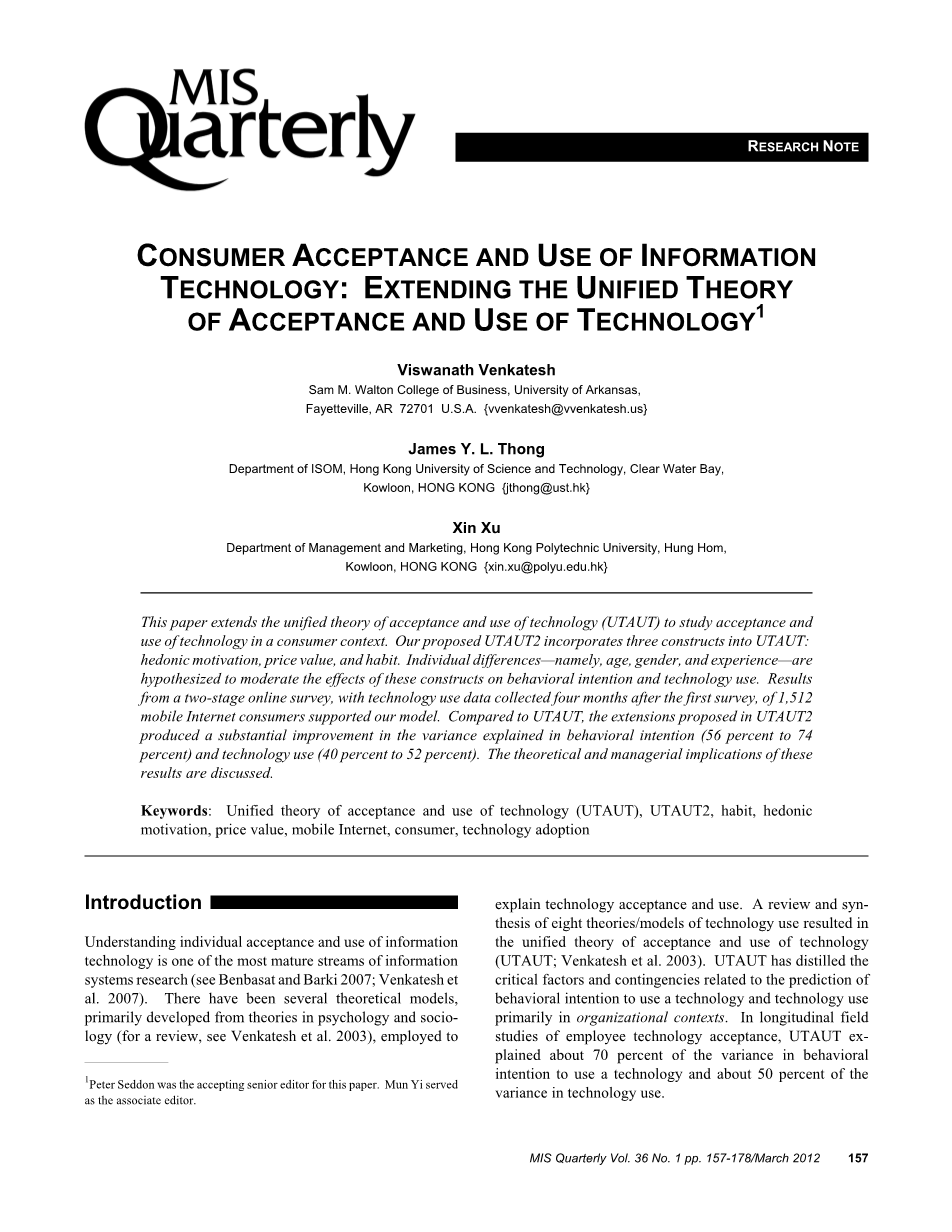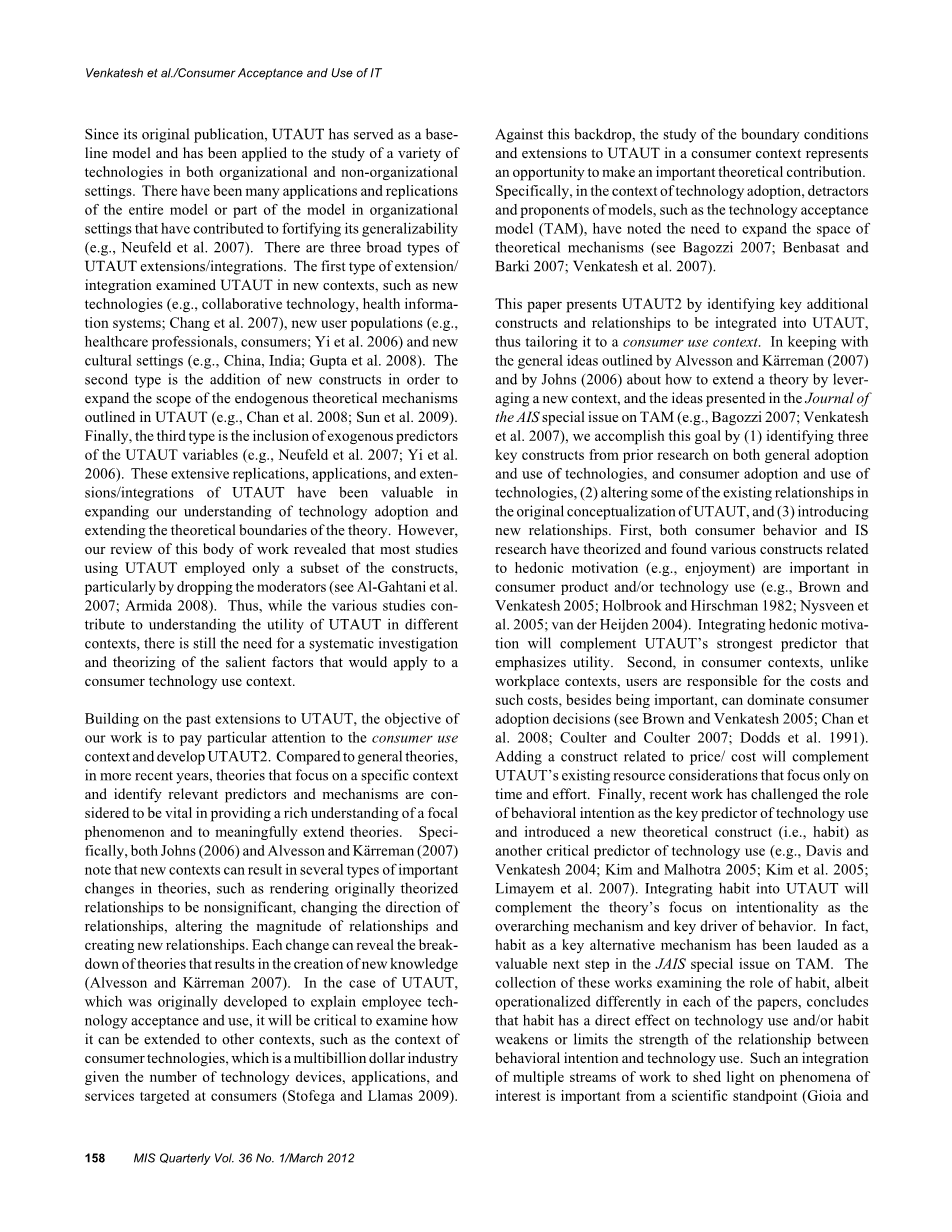

英语原文共 22 页,剩余内容已隐藏,支付完成后下载完整资料
CONSUMER ACCEPTANCE AND USE OF INFORMATION TECHNOLOGY: EXTENDING THE UNIFIED THEORY OF ACCEPTANCE AND USE OF TECHNOLOGY
消费者对信息技术的接受和使用:扩大统一的接受和使用技术理论
Viswanath Venkatesh
Sam M. Walton College of Business, University of Arkansas, Fayetteville, AR 72701 U.S.A. {vvenkatesh@vvenkatesh.us}
Viswanath Venkatesh
萨姆M.沃尔顿商学院,阿肯色大学,费耶特维尔,AR 72701美国{vvenkatesh@vvenkatesh.us}
James Y. L. Thong
Department of ISOM, Hong Kong University of Science and Technology, Clear Water Bay, Kowloon, HONG KONG {jthong@ust.hk}
James Y. L. Thong
香港九龙清水湾香港科技大学ISOM部{jthong@ust.hk}
Xin Xu
Department of Management and Marketing, Hong Kong Polytechnic University, Hung Hom, Kowloon, HONG KONG {xin.xu@polyu.edu.hk}
辛旭
香港九龙红磡香港理工大学管理及市场学系{xin.xu@polyu.edu.hk}
This paper extends the unified theory of acceptance and use of technology (UTAUT) to study acceptance and use of technology in a consumer context. Our proposed UTAUT2 incorporates three constructs into UTAUT: hedonic motivation, price value, and habit. Individual differences—namely, age, gender, and experience—are hypothesized to moderate the effects of these constructs on behavioral intention and technology use. Results from a two-stage online survey, with technology use data collected four months after the first survey, of 1,512 mobile Internet consumers supported our model. Compared to UTAUT, the extensions proposed in UTAUT2 produced a substantial improvement in the variance explained in behavioral intention (56 percent to 74 percent) and technology use (40 percent to 52 percent). The theoretical and managerial implications of these results are discussed.
Keywords: Unified theory of acceptance and use of technology (UTAUT), UTAUT2, habit, hedonic motivation, price value, mobile Internet, consumer, technology adoption
本文扩展了统一的技术接受和使用理论(UTAUT),以研究消费者对技术的接受和使用。我们提出的UTAUT2在UTAUT中包含三个构成:享乐动机,价格价值和习惯。假设个体差异 - 即年龄,性别和经验 - 可以缓解这些构念对行为意图和技术使用的影响。在第一次调查四个月后收集的1,512个移动互联网消费者的技术使用数据支持了我们的模型,两阶段在线调查的结果。与UTAUT相比,UTAUT2中提出的扩展在行为意向(56%至74%)和技术使用(40%至52%)中解释的方差产生了实质性改善。讨论这些结果的理论和管理意义。
关键词:统一接受和使用技术理论(UTAUT),UTAUT2,习惯,享乐动机,价格价值,移动互联网,消费者,技术采用
Introduction
Understanding individual acceptance and use of information technology is one of the most mature streams of information systems research (see Benbasat and Barki 2007; Venkatesh et al. 2007). There have been several theoretical models, primarily developed from theories in psychology and sociology (for a review, see Venkatesh et al. 2003), employed to explain technology acceptance and use. A review and synthesis of eight theories/models of technology use resulted in the unified theory of acceptance and use of technology (UTAUT; Venkatesh et al. 2003). UTAUT has distilled the critical factors and contingencies related to the prediction of behavioral intention to use a technology and technology use primarily in organizational contexts. In longitudinal field studies of employee technology acceptance, UTAUT explained about 70 percent of the variance in behavioral intention to use a technology and about 50 percent of the variance in technology use.
了解个人对信息技术的接受和使用是最成熟的信息系统研究之一(参见Benbasat和Barki 2007; Venkatesh等2007)。 有几种理论模型主要是从心理学和社会学理论发展而来的(综述参见Venkatesh et al。2003),用于解释技术的接受和使用。 对八种技术使用理论/模型的综述和综合形成了统一的技术接受和使用理论(UTAUT; Venkatesh et al.2003)。 UTAUT已经提炼出了与行为意图预测相关的关键因素和意外事件,以便主要在组织环境中使用技术和技术。 在对员工技术接受度的纵向实地研究中,UTAUT解释了约70%的使用技术的行为意向差异和约50%的技术使用差异。
Since its original publication, UTAUT has served as a baseline model and has been applied to the study of a variety of technologies in both organizational and non-organizational settings. There have been many applications and replications of the entire model or part of the model in organizational settings that have contributed to fortifying its generalizability (e.g., Neufeld et al. 2007). There are three broad types of UTAUT extensions/integrations. The first type of extension/ integration examined UTAUT in new contexts, such as new technologies (e.g., collaborative technology, health information systems; Chang et al. 2007), new user populations (e.g., healthcare professionals, consumers; Yi et al. 2006) and new cultural settings (e.g., China, India; Gupta et al. 2008). The second type is the addition of new constructs in order to expand the scope of the endogenous theoretical mechanisms outlined in UTAUT (e.g., Chan et al. 2008; Sun et al. 2009). Finally, the third type is the inclusion of exogenous predictors of the UTAUT variables (e.g., Neufeld et al. 2007; Yi et al. 2006). These extensive replications, applications, and extensions/integrations of UTAUT have been valuable in expanding our understanding of technology adoption and extending the theoretical boundaries of the theory. However, our review of this body of work revealed that most studies using UTAUT employed only a subset of the constructs, particularly by dropping the moderators (see Al-Gahtani et al. 2007; Armida 2008). Thus, while the various studies contribute to understanding the utility of UTAUT in different contexts, there is still the need for a systematic investigation and theorizing of the salient factors that would apply to a consumer technology use context.
自其最初发表以来,UTAUT已成为基准模型,并已应用于组织和非组织环境中各种技术的研究。整个模型或模型的一部分在组织设置中有许多应用和重复,这有助于增强它的普遍性(例如Neufeld et al。2007)。有三大类UTAUT扩展/集成。第一种类型的扩展/整合考察了UTAUT在新的背景下的应用,如新技术(如协作技术,健康信息系统,Chang等,2007),新的用户群(如医疗保健专业人员,消费者,Yi et al.2006 )和新的文化背景(如中国,印度; Gupta等2008)。第二类是为了扩大UTAUT中概述的内生理论机制的范围(例如Chan等人2008; Sun等人2009)而添加新的构建体。最后,第三种类型是包含UTAUT变量的外生预测因子(例如,Neufeld等,2007; Yi等,2006)。 UTAUT的这些广泛的复制,应用和扩展/集成对于扩展我们对技术采用的理解并扩展理论的理论界限非常有价值。然而,我们对这部分工作的回顾显示,大多数使用UTAUT的研究仅使用了一部分构建体,特别是通过放弃版主(参见Al-Gahtani等2007; Armida 2008)。因此,尽管各种研究有助于理解UTAUT在不同背景下的效用,但仍然需要对适用于消费者技术使用背景的
全文共99357字,剩余内容已隐藏,支付完成后下载完整资料
资料编号:[12374],资料为PDF文档或Word文档,PDF文档可免费转换为Word
以上是毕业论文外文翻译,课题毕业论文、任务书、文献综述、开题报告、程序设计、图纸设计等资料可联系客服协助查找。


